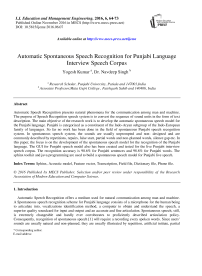Automatic Spontaneous Speech Recognition for Punjabi Language Interview Speech Corpus
Автор: Yogesh Kumar, Navdeep Singh
Журнал: International Journal of Education and Management Engineering(IJEME) @ijeme
Статья в выпуске: 6 vol.6, 2016 года.
Бесплатный доступ
Automatic Speech Recognition presents natural phenomena for the communication among man and machine. The purpose of Speech Recognition speech system is to convert the sequence of sound units in the form of text description. The main objective of the research work is to develop the automatic spontaneous speech model for the Punjabi language. Punjabi is categorized as a constituent of the Indo-Aryan subgroup of the Indo-European family of languages. So far no work has been done in the field of spontaneous Punjabi speech recognition system. In spontaneous speech system, the sounds are usually unprompted and non- designed and are commonly described by repetitions, repairs, false start, partial words and non-planned words, silence gap etc. In this paper, the focus is on the development of the spontaneous speech model for the recognition of the Punjabi language. The GUI for Punjabi speech model also has been created and tested for the live Punjabi interview speech corpus. The recognition accuracy is 98.6% for Punjabi sentences and 98.8% for Punjabi words. The sphinx toolkit and java programming are used to build a spontaneous speech model for Punjabi live speech.
Sphinx, Acoustic model, Feature vector, Transcription, Field file, Dictionary file, Phone file
Короткий адрес: https://sciup.org/15014042
IDR: 15014042
Список литературы Automatic Spontaneous Speech Recognition for Punjabi Language Interview Speech Corpus
- Yogesh Kumar and Navdeep Singh. A First Step towards an Automatic Spontaneous Speech Recognition System for Punjabi Language. International Journal of Statistics and Reliability Engineering, Vol. 2 (1), PP. 81- 93, 2015.
- M.Izzad, Nursuriati Jamil. Speech/Non-Speech Detection in Malay Language Spontaneous Speech. IEEE proceeding, PP: 219-224, 2013.
- Wiqas Ghai and Navdeep Singh. Analysis of Automatic Speech Recognition Systems for Indo-Aryan Languages: Punjabi a Case Study. International Journal of Soft Computing and Engineering, ISSN: 2231-2307, Volume-2, Issue-1, PP. 379-385, 2012.
- Wiqas Ghai and Navdeep Singh. Tri-Phone Based Acoustic Modeling On Continuous Speech Recognition for Punjabi Language. IJCA, Vol-72, pp. 23-28, 2013.
- Mohit Dua, R.K.Aggarwal. Punjabi Automatic Speech Recognition Using HTK. IJCSI International Journal of Computer Science Issues. Vol. 9, Issue 4, No. 1, PP.359-364, 2012.
- Jeet Kumar, Om Prakash Prabhakar and Navneet Kumar Sahu. Comparative Analysis of Different Feature Extraction and Classifier Techniques for Speaker Identification Systems: A Review. International Journal of Innovative Research in Computer and Communication Engineering, Vol. 2, Issue 1, PP. 2760-2269. 2014.
- Chetana Prakash, Suryakanth V. Gangashetty. Fourier-Bessel Cepstral Coefficients for Robust Speech Recognition. Proceeding of IEEE, PP. 1-5, 2012.
- Anupriya Sharma, Amanpreet Kaur. A Survey on Punjabi Speech Segmentation into Syllable-Like Units Using Group Delay. International Journal of Advanced Research in Computer Science and Software Engineering, Volume 3, Issue 6, June 2013.
- Anusuya, M. A., Katti. Front end analysis of speech recognition: A review. International Journal of Speech Technology, Springer, Vol.14, PP. 99–145, 2011.
- Kumar, R. Comparison of HMM and DTW for Isolated Word Recognition System for Punjabi Language. International Journal of Soft Computing, PP.88-92, 2010.
- N.Uma Maheswari, A.P.Kabilan and R.Venkatesh. A Hybrid model of Neural Network Approach for Speaker indepen-dent Word Recognition. International Journal of Computer Theory and Engineering, Vol.2, No.6, PP.1793-8201, 2010.
- www.shabdkosh.com/pa/.../corpus/corpus-meaning-in-Punjabi-English.
- http://cmusphinx.sourceforge.net/
- https://corplinguistics.wordpress.com/tag/punjabi/
- http://research.microsoft.com/pubs/118769/Book-Chap-HuangDeng2010.pdf.


